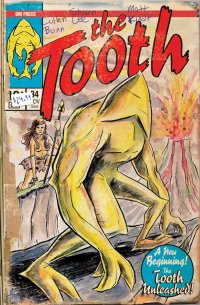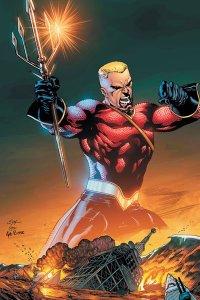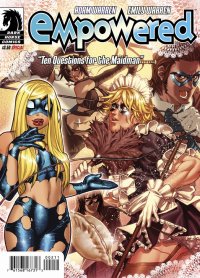The Tooth HC (Oni Press, $24.99)
By Graig Kent
I have to admit I’m a huge sucker for projects with an elaborate, yet fictional, history, the kind that builds a world outside of its core story. Black Dynamite is a great recent example, a film that is as much about how it was made as the story it tells, both of which are used to incite different levels of comedy. In a recent Nerdist Podcast with the creators of Black Dynamite, they explain how, on-set, they sort of established alternate personalities to get into the groove of making a 70’s style film (star/co-creator/co-writer Michael Jai White, for instance, played the role of a 1970’s ex-football star Farrante Jones playing Black Dynamite). It’s touches like that which make me smile, that additional effort makes me smile all the more.
Similarly, Oni Press’ The Tooth isn’t just a hardcover package that presents to the reader a six-chapter story, but also provides the reader the experience of reading a six chapter story. While tangibly it’s an original graphic novel, metatextually The Tooth is a journey into some kid named Jimmy’s home-made scrapbook to his favorite series. The opening pages feature sketches of the Tooth character, made to look as if they were drawn by the same person at a different age. There’s poems, fan fiction, a stats page, a “have/need” checklist for the character, school writing assignments written about the character, and other such things any reader who was comic-obsessed as a kid/teen would recognize from their own past.
But on top of the exterior world building, there’s also an interior world building. The five “The Tooth” comics within (yes, I said it presents a six-issue story, but there’s an issue missing from Jimmy’s collection) have retro-style advertisements, as well as letter columns which expand greatly upon the world of the Tooth that is presented within the book. There’s talk of past events, older series, and other characters — villains and heroes alike — all unseen, but discussed in “fan letters” with a passion (with an equal mix of positivity and negativity as one would come to expect from letter columns of yore). Better yet, by the time one reaches the “final issue” in this book, the letter columns have already looped back to the issues that opened it. Serious meta.
The actual “The Tooth” comic itself — as written by Cullen Bunn (of the fantastic The Sixth Gun fame) and Shawn Lee, with Matt Kindt (creator of the awesome Super-Spy) — is an absolute delight in and upon itself. While I’m no connoisseur of ’50’s- or ’60’s-era horror/suspense comics (like Tales From The Crypt or House of Mystery) I can recognize the inspiration they’re taking from them, with an unseen narrator directing the audience through the events, providing commentary as often as exposition. Bunn and Lee take the narration to a whole different level, a wry sense of humor constant, though never overwhelming the actual story.
And what a story… In many respects it’s a long-form tribute to those old horror/suspense comics, with much of the requisite trappings: small town setting, voodoo witchcraft, monsters, the reluctant hero, and the like. In this case Graham Stone has come from the big city with his fiancee to settle the affairs of his recently passed uncle. Upon investigating the premises he’s roughed up by some hooligans at the orders of a distinctly Southern snakeoil salesman-type name Caleb King. They’re after a Tooth, but the only one they get is one extracted from Graham’s mouth. But Graham is shocked to find that there is a tooth, one that comes alive and protects him in times of need, one that’s at his command, and when it’s duty is done, it fills that recently created gap in his mouth until he’s needed again. Over the course of the “six” issues we learn the secret origin of the Tooth (for the first time apparently), meet his family, witness the birth of a patchwork dragon, and plenty of that old black magic courtesy of the nefarious Caleb King.
Much like the recent Black Dynamite comic (which I reviewed here), The Tooth is a nostalgia trip into something entirely brand new. While there’s a retro sensibility to the comic, Bunn, Lee and Kindt don’t give into being exceedingly hoary or hokey with it, but instead opt for entertaining. The use of old formats or styles are an immediate way to connect with a reader who is familiar with them, but it’s backed up with something unique that entices the reader into wanting more. With a deep (if completely made-up) publishing history, here’s hoping there’s more Tooth to brush up on in the future.
Rating: 




Out of a Possible 5 Stars
 Flashpoint: Emperor Aquaman #1, DC, $2.99
Flashpoint: Emperor Aquaman #1, DC, $2.99
By Adam Prosser
Most superhero comics readers claim to be sick of “event comics”. Heck, I’d say I feel the same way, and I’m a guy who doesn’t read a lot of mainstream superhero books. But when I think about it, the specific aspect that bothers me is a little hard to pin down. The go-to answer is that it’s frustrating to be constantly told of events that will CHANGE THINGS FOREVER, when we know things are going to be back to the status quo in a year or so. But really, this isn’t an issue with storytelling; it’s an issue of hype. The Marvel and DC characters are works of multi-authorship, expected to continue forever, so it’s only natural that a certain status quo will return at regular intervals. And it’s just as natural that a talented author will attempt to shake things up in the course of his or her run. That’s a storyteller’s job, to come up with new things for the characters to do.
The problem, then, is a lack of proportion; rather than treating each new story twist or reinvention as part of the natural procession of things, the Big Two treat them as massive events (which have to then impact all the other books and usually come accompanied by gimmicks like, say, pointless relaunches and renumbered issues). I firmly believe that the best way to judge the success or failure of an “event” is to detach it from the hype and the concerns about continuity and simply view it as a self-contained storyline-a “what if” tale, as it were. Certainly, when you’re a casual superhero reader like myself, who’s unlikely to have read the stories that came before or after or any of the numerous tie-ins, the average event is likely to come off as a little continuity bubble whose impact is likely to seem inconsequential.
In that sense, Flashpoint might have an advantage over other event comics, in that no one expects it to have a lasting impact on the DC Universe; the fact that it’s quite literally “changed everything” almost seems like a sly joke on the part of DC, a sort of meta-commentary on the nature of event comics. But the practical result is a series of miniseries that are going to quite literally have to stand on their own.
One such is Emperor Aquaman, written by Tony Bedard with art by Ardian Syaf and Vicente Cifuentes. In this alternate universe, Atlantis is at war with Themiscyra for reasons that aren’t made clear–it’s suggested that Aquaman had Wonder Woman’s mother assassinated on the eve of what was supposed to be their politically arranged marriage, which if true makes this Aquaman is a pretty cold bastard. (Though apparently he was married to Mera a short time later, so maybe this is a case of “following your heart” gone horrifically wrong…) This book jumps back and forth through time to show how Aquaman kidnapped Brion “Geo-Force” Markov and turned him into a living weapon to submerge most of Western Europe-without, apparently, managing to get those pesky Amazons, who had Brion’s similarly-empowered sister working for them.
The chronological jumps seem somewhat pointless–you get the sense that this story is told in non-linear fashion simply because that’s how superhero stories are told these days. But the actual narrative is clear enough, and the story that’s being told here is certainly epic. While it relies to a certain extent on its audience thinking “Wow, Aquaman’s gone nuts! And he’s at war with the Amazons? That’s crazy!” the book doesn’t trot out a cavalcade of DC guest stars just to score nerd points, something I have to give it credit for. As a sort of “All-Star Dark Aquaman”, it works well enough-it’s nothing revolutionary, but it’s a solid action-adventure comic.
My local comics retailer mentioned that his customers had seemed rather apathetic about Flashpoint, until the DC reboot was announced, at which point the books instantly started selling out. Superhero comics readers have, sadly, been trained to believe that a story’s worth is measured by how much it “matters” to what’s coming next. At least with Flashpoint, no one’s going to be complaining when things go back to the way they were in a few months, so maybe it’s just possible that they’ll be able to enjoy these stories as stories.
Rating: 




Out of a Possible 5 Stars
Flashpoint: Citizen Cold #1 (DC, $2.99)
By Jeb D.
Though I know its general outlines, I’m not intimately familiar with the DCU: I tend to drop in for the odd Crisis, or special project (New Frontier, All Star Superman, etc.), but the decades of accretion always make it feel more like homework than pleasure reading, and it never seems to stick with me. So I figured that makes me an ideal candidate for what I think I perceive Flashpoint to be: a chance for a fresh start with a renewed universe. Given that, I figured I should choose the freshest start I could find, and skipping over anything involving familiar characters related to Batman or Superman, I settled on Citizen Cold.
I vaguely recall Captain Cold from my Silver Age childhood, but I began with the assumption that he’d been appropriately grimmed and gritted over the ensuing decades. And the story wasn’t a particular surprise in that department: “Citizen” Cold has become a sort of anti-hero (possibly running the Thunderbolts playbook, though that’s for future issues), taking on baddies like Mr. Freeze, and being hailed as a hero (with unconvincing shouts from the crowds of things like “Cold Snap!”) by a Central City populace that not only doesn’t seem to realize that he’s an anti-hero, but that he’s a grim and gritty anti-hero (he appears to brutally murder Mr. Freeze, but if Arnold couldn’t kill that fucker, no one can), with a grim and gritty backstory, and as little regard for his presumed constituents as the Bomb Queen. It’s not a bad twist, of course, but something of the dark wit that a Warren Ellis or Gath Ennis brings to this sort of concept would be welcome.
Still, that’s not a fatal problem, and on those limited terms, writer-artist Scott Kolins does a serviceable job. But it’s the backdrop of the basic story that’s a little less than welcoming for the newbie.
Early on, we meet “Iris” and “Wally.” And we visit a prison where a bunch of unnamed (but grim) (oh, and gritty) supervillains are stewing and plotting, and snarling out the threat that these “Rogues” will get out and wreak some serious mayhem (was The Flash the first hero to have his collective antagonists referred to as a “Rogues’ Gallery”?). As I say, I’m familiar enough with the dramatis personae of the DCU to get who most of these characters are, but their presentation is full of “wink wink nudge nudge” Easter eggisms to keep the regular DCU readers happy (we even get a TV newscaster in the background bringing us up to date on the happenings with Wonder Woman and “Emperor Aquaman”), peppering the story with a distracting series of “connect the dot” references, making the new reader acutely aware that they’re already several steps behind the story. This culminates with the cliffhanger fate of Wally, which only becomes consequential if a reader brings with them some expectations and/or affection for his one-time incarnation of The Flash; for the new reader (who is the presumed audience for the book), he’s just some guy stuck in green goo.
While I know Kolins’ art mostly from Marvel Team-Up and Omega Flight, I know he’s worked extensively on The Flash before, and while the storytelling is fine, visually, the book could use a dash or two of Scarlet Speedster, as it’s kind of a study in drab dark blues and greys.
It’s tough to know how (or if) to recommend this comic: with all the other choices out there, it’s kind of hard to imagine anyone dropping coin on this book unless they were a fairly committed DCU fan who wanted to see a twist on a C-list character. Nothing wrong with that, of course, but somehow I thought this project was supposed to be about something more than that. A nice book that only fans of Kolins are likely to find in any way essential.
Rating: 




Out of a Possible 5 Stars
 Empowered Special #2: “Ten Questions For The Maidman” (Dark Horse, $3.50)
Empowered Special #2: “Ten Questions For The Maidman” (Dark Horse, $3.50)
By Jeb D.
On his Deviant Art site recently, writer-artist Adam Warren was exhorting fans to turn out in strength to support this book, in order to ensure that, given the uncertainties regarding publication of future issues, he’d actually be able to release the next full-size volume in 2012. And, frankly, that was one of the most incredible things I’ve read recently: a comic that combines action, wit, humor (not the same thing), insight into topics from sex to superheroes (OK, that’s not really all that wide a spectrum), strong characterization, compelling storytelling, and highly kinetic East-meets-West artwork is… well, OK, maybe not a Top Ten book, I can see that, but how on earth can such accomplished work not even find a minority audience large enough to keep it confidently afloat? And at Dark Horse, no less, a publisher that knows how to cultivate niche tastes?
Ah, well… people watch American Idol, too, while Shawn Ryan can’t even squeeze two seasons out of The Chicago Code. The vagaries of pop culture.
Anyway, what we have here is another brilliantly funny outing with insecure, distress-prone superheroine Empowered, her supporting cast of self-absorbed, lusty misfits, and their pointedly-parodied adversaries. This time, the principal storyline revolves around the crossdressing Maidman, whose neat-freak tendencies and punctilious manners remind me of a transvestite version of the National Lampoon’s old Politenessman. Maidman has no superpowers (unless you count his various skills with feather dusters and potstickers), but he’s managed to intimidate his homophobic rogues’ gallery (you might connect that to the typical American comics reader; Warren couldn’t possibly comment) with their fear that this studly-looking dude in the French maid’s outfit is going to use that mop handle to… well, to DO something to them.
This is revealed in the course of a TV interview being conducted by a bland superhero chat-show host named “Blitzcraig,” and it’s quite possibly the funniest thing Warren has written yet, with Maidman a Batman sendup (his arsenal of tidyness includes “doilyrangs”) that makes The Boys look positively clumsy; my favorite bits include the exchange of facial expressions when Maidman informs his host that “Studies show that the male gaze is automatically drawn to the crotch when looking at any human figure. Science!“; and his defense of crossdressing as a super-costume: “The hundreds of would-be badass capes who practice species crossdressing as various theoretically intimidating animals? That’s one step removed from being a furry! Talk about embarrassing!”
Empowered herself isn’t ignored by any means, as the adventure that is intercut with the interview story sees her invoking of Maidman’s name to strike fear into the hearts of her foes; with the funny, predictable result that our resourceful heroine is once more at the mercy of snarky supervillains whose assembled powers are no match for our heroine’s good heart and common sense… well, and the timely intervention of the “cross-dressing crusader.”
Visually, Warren’s black and white mixture of manga, early Mad, and Ernie Chan is always a treat, but he’s trying something different this time: the interview segments are penciled by Marvel cover artist Emily Warren (“no relation,” assures Adam), and presented in full color: the work is bright and appealing, highly skilled, with the Japanese influence present, but more of a lightly accented grace note than in Adam’s segments. Given that the bulk of her assignment here consists of two men sitting around talking, her work is surprisingly dynamic, and her depiction of Maidman as a perfectly-muscled uber-dude sitting in the classically feminine cross-legged pose of one of Oprah’s guests nails the character from the first panel. And she does a terrific job on the couple of pages of action she’s handed; I’d love to see more sequentials from her.
Those looking for a “jumping-on” point for Empowered might certainly consider this, as it’s a perfect example of Warren’s unique superhero recipe of loving homage, wicked subversion, pointed commentary, and sex appeal. I feel obligated, though, to point out that you really don’t want to miss the growth (you heard me-actual character development!) that Empowered and company demonstrate over the course of the first six full-sized volumes of the series, and that while $3.50 for these 30 terrific pages of story is not a bad deal by any means, the typical $12-$15 price point on the regular editions routinely brings you 200-plus pages of the same.
But let’s face it, I want more Empowered, so you should all go out and buy this book! And the others, too!
Rating: 




Out of a Possible 5 Stars